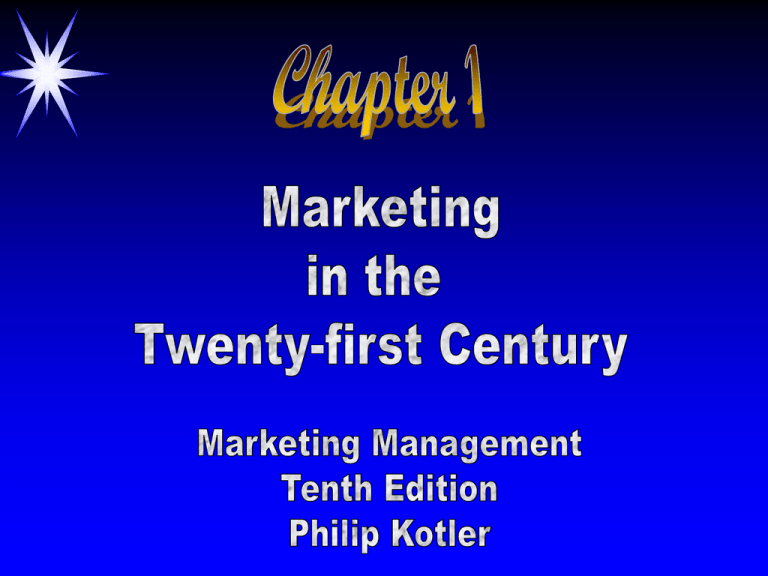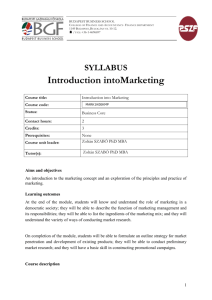Production Concept Product Concept Selling Concept Marketing
advertisement

Objectives Course Organization Tasks of Marketing Major Concepts & Tools of Marketing Marketplace Orientations Marketing’s Responses to New Challenges ©2000 Prentice Hall Course/Text Organization Part I - Understanding Marketing Management Part II - Analyzing Marketing Opportunities Part III - Developing Marketing Strategies Part IV - Shaping the Market Offering Part V - Managing & Delivering Marketing Programs ©2000 Prentice Hall Defining Marketing Marketing is a societal process by which individuals and groups obtain what they need and want through creating, offering, and freely exchanging products and services of value with others. - Philip Kotler (p. 7) ©2000 Prentice Hall Core Concepts of Marketing Target Markets & Segmentation Needs, Wants, and Demands Product or Offering Value and Satisfaction Exchange and Transactions Relationships and Networks Marketing Channels Supply Chain Competition Marketing Environment ©2000 Prentice Hall Simple Marketing System Communication Industry (a collection of sellers) Goods/services Money Information ©2000 Prentice Hall Market (a collection of Buyers) Structure of Flows Resources Money Resource markets Services, money Services, money Manufacturer markets Goods, services ©2000 Prentice Hall Taxes, goods Taxes Government markets Taxes, goods Services, money Money Resources Money Consumer markets Services Taxes, goods Money Intermediary markets Goods, services The Four Ps The Four Cs Marketing Mix Place Product Customer Solution ©2000 Prentice Hall Price Customer Cost ConvenPromotion ience Communication Company Orientations Towards the Marketplace Production Concept Consumers prefer products that are widely available and inexpensive Product Concept Consumers favor products that offer the most quality, performance, or innovative features Selling Concept Consumers will buy products only if the company aggressively promotes/sells these products Marketing Concept Focuses on needs/ wants of target markets & delivering value better than competitors ©2000 Prentice Hall Customer Delivered Value Starting point Focus Means Ends Factory Existing products Selling and promotion Profits through sales volume (a) The selling concept Market Customer needs Integrated marketing Profits through customer satisfaction (b) The marketing concept ©2000 Prentice Hall Traditional Organization Chart Top Management Middle Management Front-line people Customers ©2000 Prentice Hall Customer-Oriented Organization Chart Customers Front-line people Middle management Top management ©2000 Prentice Hall Evolving Views of Marketing’s Role Finance Production Marketing Finance Human resources a. Marketing as an equal function ©2000 Prentice Hall Production Human resources Marketing b. Marketing as a more important function Evolving Views of Marketing’s Role Production Marketing c. Marketing as the major function ©2000 Prentice Hall Customer d. The customer as the controlling factor Evolving Views of Marketing’s Role Production Marketing Customer e. The customer as the controlling function and marketing as the integrative function ©2000 Prentice Hall Review Course Organization Tasks of Marketing Major Concepts & Tools of Marketing Marketplace Orientations Marketing’s Responses to New Challenges ©2000 Prentice Hall






